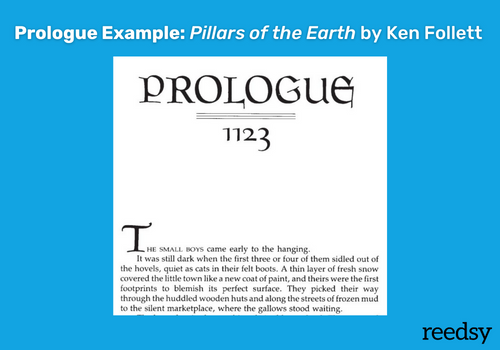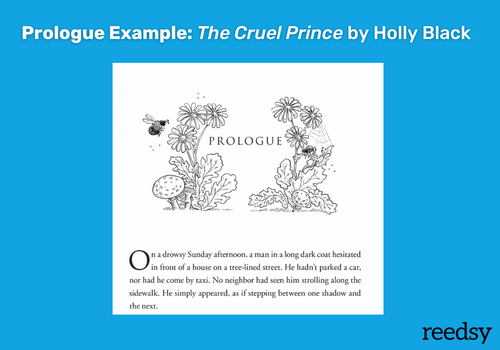Guides •
Last updated on Mar 17, 2023
Prologue in a Book: The Story Before the Story
A prologue is a short opening section in a book that is separate from the main narrative. Taking place within the story's world, they provide the reader with character backstory, worldbuilding, or foreshadowing. Prologues come at the beginning of a book; after any copyright, dedication, and epigraph pages. There’s no set length, but a prologue is usually shorter than a standard chapter.
A prologue is different from a preface, which is written from the perspective of the author and isn’t fictional. It’s also different from an introduction or foreword, both of which are generally found in nonfiction — the former being a summary of the author’s arguments while the latter is written by someone other than the author.
Now that we’ve covered what a prologue isn’t, let’s take a deeper dive into what prologues can do, along with some examples of great ones from literature.
Looking to learn how to write your own prologue? Check out our guide right here.
A prologue can create intrigue at the book’s opening
Authors often use a prologue to hook readers into a story by previewing what’s to come. In giving a taste of mystery or conflict to its readers, a prologue can whet their appetite for more.
These types of prologues sometimes take place at the story's climax. They may center on characters that don’t appear in the rest of the book. They may even be a description of an incident that seems completely unrelated to the book. The idea here is to throw readers into the deep end and get them asking questions: who are these people? How did the story get to this point? How does it tie into the bigger story?

FREE COURSE
How to Plot a Novel in Three Acts
In 10 days, learn how to plot a novel that keeps readers hooked
By immediately introducing some kind of tension or intrigue, a prologue can pique the readers’ interest and reel them in with the promise that all will be revealed in due course.
Example: Ninth House by Leigh Bardugo
Packed with mystery and action, Leigh Bardugo’s paranormal fantasy begins in medias res. Protagonist Alex Stern is seemingly trapped in a house, reading notes left by members of a secret society. She’s also injured — something has bitten her, and there’s no one around to lend a helping hand.
Laced with threads of information about a mysterious association and a strong dose of high stakes, Ninth House gets readers asking questions with its prologue; what is this secret society? Where is this mysterious house? Will Alex survive her injury? All of these questions build suspense and can only be answered by turning the pages.
📚 Looking for more fantasy titles to add to your TBR? Check out this list of the 60 best fantasy books of all time.
While prologues are great at flipping the switch that turns casual readers into armchair detectives, they can also be deployed in ways that will inform how readers process the rest of the book.
Themes are often introduced in the prologue
Since they often don’t directly relate to the main plot of the book, prologues can easily baffle readers. However, a seemingly unrelated prologue might be a sign that the author is planting an image or an idea they will want the reader to subconsciously draw on throughout the book. They might also be frontloading the book with a scene that focuses on a particular theme, encouraging readers to take in the rest of the narrative through a certain lens or with a particular frame of reference.
Example: Crazy Rich Asians by Kevin Kwan
This extravagant and satirical novel lives up to its name by beginning with a prologue set in the lobby of a luxury hotel in London, 1986. A family of Chinese tourists arrive soaked from the (unusually heavy) English rain. When the manager refuses to let them check in to their suite, the matriarchs of the family quickly deduce it’s down to the hotelier’s prejudice. One quick phone call later, the family now owns the hotel, and send the snooty manager packing.

As we discover later, one of the children in this family is Nick, who is a major character in the book. The prologue reveals the kind of power that Nick’s family is used to wielding. This level of wealth may baffle Nick’s girlfriend, Rachel, later in the story, but not the readers — thanks to the prologue, we already know exactly how rich they are: crazy rich.
It isn’t always quite so on the nose, but authors often foreshadow major conflicts and themes in the prologue. By highlighting the Youngs’ unattainable lifestyle, the prologue of Crazy Rich Asians hints at the disparity that undergirds the central conflict of Nick and Rachel’s romance, as well as the general theme of class which beats throughout the novel. In this way, the prologue functions as a successful example of show, don’t tell, establishing some central points of tension.

FREE COURSE
Show, Don't Tell
Master the golden rule of writing in 10 five-minute lessons.
So far, we’ve looked at prologues as a way to prepare readers for the story’s narrative. But in many cases, especially in genre fiction, you’ll see them used as a tool to introduce readers to the world of the book.
It can be used for efficient worldbuilding
Prologues are a great opportunity for worldbuilding, especially in genres like sci-fi, fantasy, and historical fiction, where the reader might not understand the rules of your world and its setting. By picking some relatively recognizable details of the world and spotlighting them with a teaser scene, authors can transition readers from the real world to their fictional one.

FREE RESOURCE
The Ultimate Worldbuilding Template
130 questions to help create a world readers want to visit again and again.
Example: Pillars of the Earth by Ken Follett
This epic historical novel opens with the public hanging of a character who doesn’t appear again in the story but whose fate drives the rest of the plot. As well as recounting an event that will have a seismic effect on the story, the prologue creates a vivid image of 12-century England. 
By capturing the atmosphere on the day, with its open gallows, anticipating spectators, and witch who cries out a curse after the execution, Follett draws readers into the era in which this Medieval tale unravels.
As well as giving readers a glimpse into the world of the story, prologues are often used to introduce something critical about the book’s primary characters.
A prologue can build character backstory
Prologues can add nuance to a narrative, using a different time frame or location (or both) to provide key background information about characters or plot. It can help readers understand how a character has ended up where they are by the first chapter quickly and efficiently.
You’ll often see backstory prologues in book series, where a later installment may start by taking a character that readers already know. It could show them earlier in their lives — perhaps before they became the person they are in the main narratives. Just as often, though, you’ll find prologues used to introduce characters for the first time.
💡 Think your story might warrant more than one book? Check out our tips for writing a series here.
Example: The Cruel Prince by Holly Black
This first installment of Holly Black’s The Folk of the Air series opens with a mysterious faerie knight arriving at a cozy family home. Standing at the door, he menacingly demands the child that his human wife had taken from him. As said child and her siblings watch on confused, their human father rushes to his wife’s side. The faerie strikes the parents down with ease, taking the bewildered children — now orphans — away to Faerieland.
We then cut to chapter one, set in this other world, years in the future. The kidnapped children are now grown and trying to make sense of their past as well as their position in this magical world.
This hard-hitting prologue does a lot of heavy lifting for the novel. It establishes an inciting incident that throws the young character into an unfamiliar world that she must now navigate. On top of that, it draws comparisons between the human girl who lost her family to the faerie world and the faerie knight who lost his family to the human world. These two characters are in conflict bu inextricably linked, a theme that Black’s prologue introduces right off the bat.
So far, we’ve seen that a prologue is a flexible tool that authors can deploy for a number of narrative and artistic purposes. But does that mean that every book can benefit from one?
But used poorly, a prologue can put readers off
Being the first taste readers get of a book, there’s a lot of pressure on a prologue to get it right. Executed badly, a prologue can be a drag. In fact, many authors swear against using them since there are many potential pitfalls.
Say you're trying to work on a romance about an unlucky-in-love woman finally finding true happiness. The prologue might feature a scene of her crying at home after a horrific breakup. She’s been unceremoniously dumped by her girlfriend at their anniversary dinner. On her way out of the restaurant, our tearful lead receives a phone call; her mother has just died, and, in one evening, her life as she knew it is over. Whilst this prologue provides insight into why our heroine is emotionally guarded in the subsequent love story, it doesn't intrigue the reader and it doesn't tell them anything they couldn't have figured out themselves.
🖊️
Which famous author do you write like?
Find out which literary luminary is your stylistic soulmate. Takes one minute!
This hypothetical prologue is not only an info-dump but it also overwhelms the reader with backstory instead of immersing them in action. Also, by immediately revealing why our lead is so disillusioned with love, we lose a valuable source of tension: the question of “but what could possibly have gone so wrong in her past?”. A better option could be drip-fed through flashbacks or exposition as we (and the new romantic interest) get to know her better.
So what's the lesson? Prologues are difficult to pull off, even for the most accomplished authors, and they're not always needed. They can harm a novel’s pacing by delaying the story’s true beginning, but a prologue that serves your story can be both fun and rewarding. If you want to take up the challenge of writing your own prologue, head over to our guide to writing these tricky little passages.
The next post in this guide will focus on the final piece of a book's front-matter ensemble: the preface.



